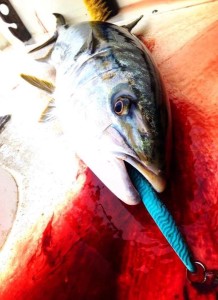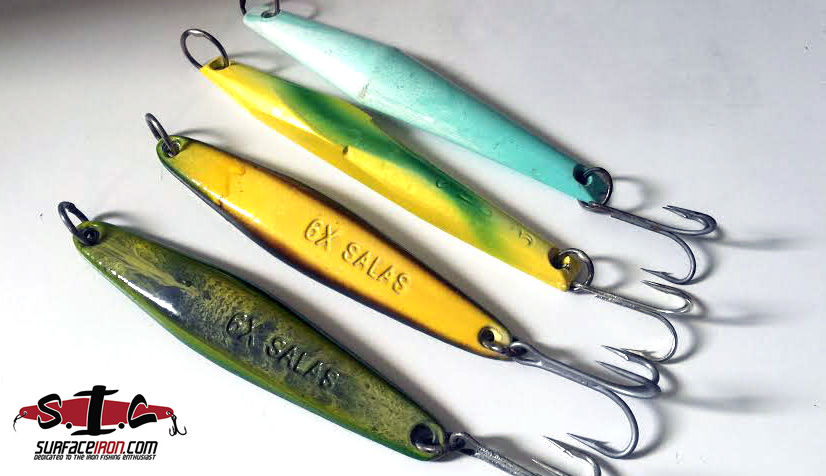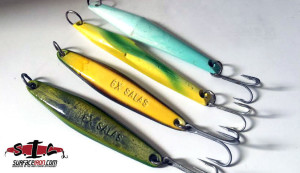“On the iron!” Three words that every angler loves to say, right? After all, have you ever met anyone who said, “I don’t like to get bit on the iron. I’d rather get ‘em on bait.” Yeah, probably not…
You actually know you’ve caught a lot of fish on the iron when you no longer announce that you’ve got bit on the iron. You also have the basics of iron fishing down when you can figure out when it’s time to fish a surface iron, and when it’s time to grab the yo-yo outfit. It doesn’t even require thought for those that fish a bunch — as in the guys that stopped saying, “Oh, on the iron!” every single time they get bit. But for fishermen just getting started with their jig fishing, figuring out the differences between the two types of jigs that are poles apart is a tough one.
While the surface iron and the yo-yo iron are both “the iron” they are totally different in terms of how and when you fish them, gear used, etc. The differences start with materials.
“A yo-yo iron is made from zinc. Surface irons are made from aluminum,” points out Matt Salas of Salas Lures. Zinc is much denser and heavier than aluminum, so the yo yo jigs sink much fastest than surface irons. Salas has started putting stickers on his yo-yo irons — like the famous 6X Jr. that probably has more confirmed kills than any jig on the market — to make it simpler for anglers going to the jig racks. “A lot of guys don’t know the difference. They hear about or read about the yo-yo iron, but they don’t know what the difference is,” say Salas.
The little yo-yo stickers make it easier for those just getting into the iron game to figure out what jigs are yo-yo lures. Then they get to become lost in a sea of colors and models…. 6X Jr., 6X, CP 105, Christy II, 9, BA, 4/0, A1, AA, 33, 5, 4, 3, 2, 1.
What can get tricky on the water can be choosing the spots where a yo-yo iron is going to be more effective than a surface iron. The yellowtail fishing off Ensenada that San Diego boats have been (or were) getting into is a prime example. There’s fish up high under bird schools — which is prime surface iron material — but the fish have been on the yo-yo lures better than the surface iron.
Yo yo irons are all about horsepower, as in turning the handle as fast as you can and covering the water column. Surface irons are for when the fish are up high in the water column, chasing bait around and boiling up around the boat. Or maybe not even boiling, but at least up high in the water column. So when do you fish either?
When the yellowtail are spread out anywhere from top to bottom, that’s when nothing beats a yo yo iron. When  fishing meter marks where you never see a fish boil up, that’s the time to grab the yo-yo. The yo-yo iron also works great when sliding into birds schools and when there are yellows up boiling around. While the surface iron might seem like the natural choice, it often isn’t when it comes to sliding into spots you can see on the surface. How come? You might be seeing fish up high, boiling around and pushing water, but what skippers call “the meat” as in the real volume and the bulk of the school, is often down below. It could be down 50 feet, it could be down 100 feet, or anywhere in between or deeper or shallower. That’s the beauty of the yo-yo iron. It covers so much water and eventually you find the zone.
fishing meter marks where you never see a fish boil up, that’s the time to grab the yo-yo. The yo-yo iron also works great when sliding into birds schools and when there are yellows up boiling around. While the surface iron might seem like the natural choice, it often isn’t when it comes to sliding into spots you can see on the surface. How come? You might be seeing fish up high, boiling around and pushing water, but what skippers call “the meat” as in the real volume and the bulk of the school, is often down below. It could be down 50 feet, it could be down 100 feet, or anywhere in between or deeper or shallower. That’s the beauty of the yo-yo iron. It covers so much water and eventually you find the zone.
One word describes yo-yo fishing: horsepower. You have to turn the handle just about as fast as you can. Rods from 6 to 7 feet that are designed for fishing 40 to 60 pound are perfect for yo-yo fishing. A big, high-speed reel with gears from 4:1 to 6:1 and 40- to 50-pound test finishes off the perfect yo-yo outfit. What about picking the right yo-yo iron? Unlike surface irons — and the topic of plenty of past columns — there’s no need to find a yo-yo iron that swims better than the rest. They all come out of one mold, and they all do the same thing: spin more than swim through the water column. Yo yo irons are the great equalized. Anyone can fish them so far as they can turn the handle fast.
In many ways, yo-yo fishing is the antithesis of surface iron fishing. There’s no need for a 9 or 10-foot rod, a well laid out cast, and knowing how fast to turn the handle to get that surface iron swimming just right. That’s the beauty of the yo-yo iron. It’s easy to get bites on what some great jig fishermen call “a sinker with a hook.”
So when do you pick up the surface iron? Anytime they’ll eat it!


